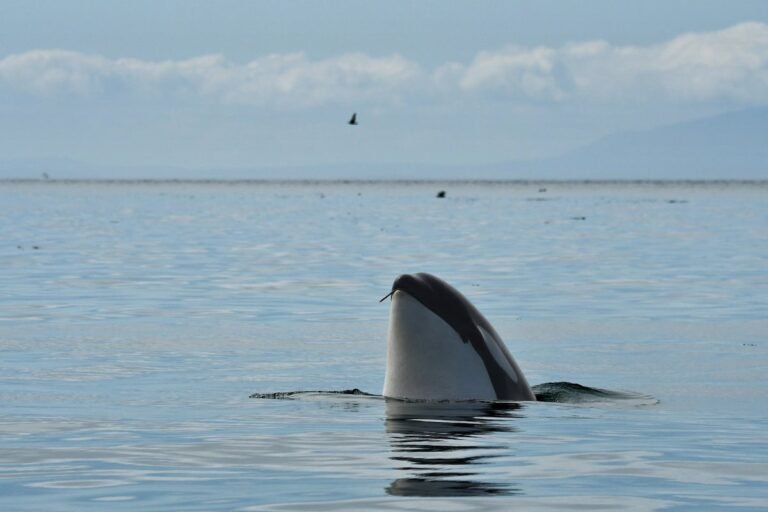Orcas’ Killer Skin-Care Routine Relies on Kelp—And Help
Massaging one another with kelp could help orcas keep their skin healthy
The southern resident killer whale J41 holds kelp in her mouth. New research suggests orcas nuzzle each other with kelp, possibly for its exfoliation effect.
Center for Whale Research, NMFS/NOAA permit 27038
Step aside, primates and crows. Thanks to new drone footage, killer whales have joined an exclusive club: the short list of animals that make and use tools.
Scientists have discovered that southern resident killer whales—an extended family of orcas that live off the coast of the Pacific Northwest in the Salish Sea —incorporate seaweed into a social grooming technique, according to a paper published on Monday in Current Biology.
Through footage from a drone more than 100 feet in the sky, the researchers watched orcas yank out sections of the stem of bull kelp, a giant seaweed that forms vast underwater forests in coastal waters. The texture of this stem, called a stipe, is firm but springy—kind of like a foam roller, says Michael Weiss, a study coauthor and behavioral ecologist at the Center for Whale Research in Friday Harbor, Wash.
On supporting science journalism
If you’re enjoying this article, consider supporting our award-winning journalism by subscribing. By purchasing a subscription you are helping to ensure the future of impactful stories about the discoveries and ideas shaping our world today.
Center for Whale Research, NMFS/NOAA permit 27038
To start a kelp-based grooming session, an orca places the bull kelp stipe on its face and nuzzles against another killer whale—often a close family member or age-mate—like an affectionate cat. The two keep the kelp pressed between their bodies as they wiggle against each other for up to 12 minutes at a time.
At first, the researchers thought this might be a form of play. There’s a longstanding cetacean fad called “kelping,” in which orcas and other whales drape leafy kelp fronds on their fins and forehead. And killer whale youngsters are fond of playing kelp keep-away. But what the southern residents are doing with the kelp stipes is neither fashion nor game, the scientists say; all ages participate, from calves to the stodgiest matriarchs, and there’s some evidence that orcas with flakier skin do it more.
The observations are “convincing evidence of tool use” in orcas, says Janet Mann, a behavioral ecologist at Georgetown University, who studies tool use in wild bottlenose dolphins and wasn’t involved in the new paper. She has spent decades following a group of dolphins in Shark Bay, Australia, that use sea sponges to protect their beak from stingers and pointy rocks as they snuffle along the seafloor to forage for food.
Overall, Mann says, researchers have seen fewer examples of tool use in aquatic environments than on land. One likely reason for this is that marine animals are streamlined for swimming, meaning their appendages typically aren’t great for grasping tools. (Notable exceptions include sea otters, who deftly juggle rocks with specially adapted paws, and octopuses, who use their many arms to chuck rocks at fishes that irk them.)
It’s also simply harder for researchers to see underwater behaviors. It’s challenging to spot the noodlelike kelp stem sandwiched between two squirming, 20-foot orcas even with the team’s 4K drone footage—“let alone if you’re on a boat looking at the surface, just seeing fins and backs coming up,” Weiss says. “Then it’s impossible.”
But why do the orcas participate in the kelp massage at all? “They’re spending a lot of time” at it, Weiss says. “It clearly takes skill and coordination.”
Ocean-dwelling cetaceans including whales and dolphins have to take skin care seriously. Their skin, while very thick, is sensitive and vulnerable to infection and parasites, Mann explains. Cetaceans’ molting cycle may even be a driving force behind cold-water whales’ annual migrations toward the equator; it’s easier to shed skin in warmer waters, previous research has suggested.
Some cetaceans find ways to help the shedding process by rubbing on coral or rocks. Weiss and his team suspect the orcas’ kelp massages may have an exfoliating effect, but further study will be needed to demonstrate that it actually improves skin health. (Think “before-and-after” shots in advertisements for your favorite face scrub.) Mann suggests other properties of the kelp could be in play, too—seaweeds are a popular ingredient in human cosmetics and could theoretically help soothe the itch of molting or somehow discourage infection or parasites.
Ultimately, the kelp massages may just feel good to the orcas. In many species, “the main function of grooming is to help build and maintain social relationships,” Weiss says. In 2024 the researchers filmed Shachi, a then 45-year-old killer whale, sharing a kelp massage with her nine-year-old grandson, Nova. Just a few days later, Tsuchi, a 29-year-old female, was spotted using kelp to groom her five-year-old daughter, Tofino. “Sometimes, that can be more important than any kind of hygienic benefit.”
Weiss and Mann agree that the finding underscores how aerial drones have changed the game for marine researchers. Scientists have been studying the southern resident pods for nearly 50 years—but it wasn’t until Weiss’s team got hold of a new drone with a more powerful zoom function that they discovered the kelp-massaging behavior. They captured it on video on the very first day they flew the new drone, Weiss says.
“It tells me there’s a lot more stuff like this out there to be found—in killer whales and in other cetaceans,” he says.
[source_link


